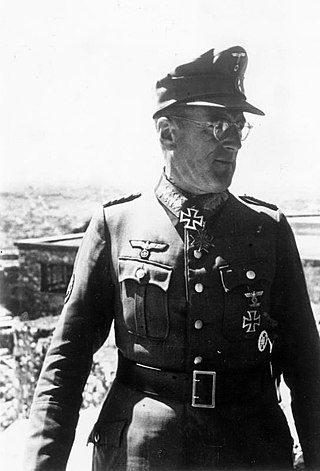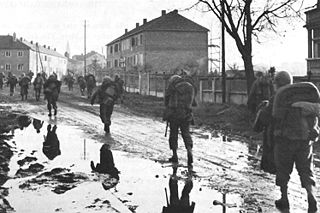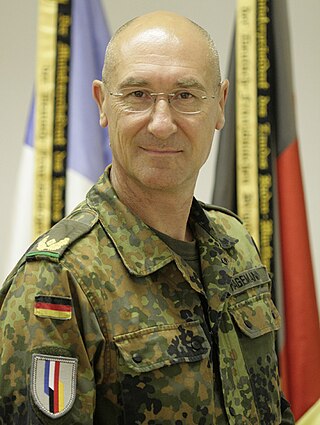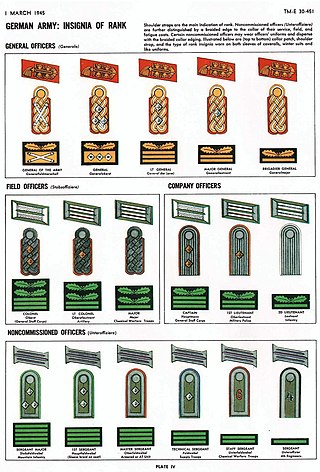
Ferdinand Schörner was a German military commander who held the rank of Generalfeldmarschall in the Wehrmacht of Nazi Germany during World War II. He commanded several army groups and was the last Commander-in-chief of the German Army.
Army Group A was the name of several German army groups during World War II. During the Battle of France, Army Group A was composed of 45½ divisions, including 7 panzer divisions. It was responsible for breaking through the heavily-forested Ardennes region. The operation, which was part of Fall Gelb, was resoundingly successful for the Germans, as the army group outflanked the best troops of France and its allies, eventually leading to France's surrender.

The Biographical Dictionary of the Extreme Right Since 1890 is a reference book by Philip Rees, on leading people in the various far right movements since 1890. It contains entries for what the author regards as "the 500 major figures on the radical right, extreme right, and revolutionary right from 1890 to the present" . It was published, as a 418-page hardcover, in New York by Simon & Schuster in 1990 (ISBN 0-13-089301-3).

A Generaloberst was the second-highest general officer rank in the German Reichswehr and Wehrmacht, the Austro-Hungarian Common Army, the East German National People's Army and in their respective police services. The rank was equal to a four-star full general but below a general field marshal. The rank was equivalent to a Generaladmiral in the Kriegsmarine until 1945 or to a Flottenadmiral in the Volksmarine until 1990. It was the highest ordinary military rank and the highest military rank awarded in peacetime; the higher rank of general field marshal was awarded only in wartime by the head of state. In general, a Generaloberst had the same privileges as a general field marshal.

Hans-Valentin Hube was a German general during World War II who commanded armoured forces in the invasions of Poland, France and the Soviet Union. In the course of the war, Hube led the 16th Infantry Division, XIV Panzer Corps, and the 1st Panzer Army rising to the rank of Generaloberst. He died in an air crash on 21 April 1944.

The Hagenbund or Künstlerbund Hagen was a group of Austrian artists that formed in 1899. The group's name derived from the name Herr Hagen, the proprietor of an inn in Vienna which they frequented.

General der Artillerie may mean:

The Battle of Metz was a battle fought during World War II at the French city of Metz, then part of Nazi Germany, from late September 1944 through mid-December as part of the Lorraine Campaign between the U.S. Third Army commanded by Lieutenant General George Patton and the German Army commanded by General Otto von Knobelsdorff. Strong German resistance resulted in heavy casualties for both sides. The city was captured by U.S. forces and hostilities formally ceased on 22 November; the last of the forts defending Metz surrendered on 13 December.

General of the Infantry is a former rank of the German army. It is currently an appointment or position given to an OF-8 rank officer, who is responsible for particular affairs of training and equipment of the Bundeswehr infantry.

General der Panzertruppe was a General of the branch OF8 rank of the German Army, introduced in 1935. A General der Panzertruppe was a Lieutenant General, above Major General (Generalleutnant), commanding a Panzer corps.

General der Flieger was a General of the branch rank of the Luftwaffe in Nazi Germany. Until the end of World War II in 1945, this particular general officer rank was on three-star level (OF-8), equivalent to a US Lieutenant general.
The Gelöbnis treuester Gefolgschaft was a declaration by 88 German writers and poets of their loyalty to Adolf Hitler. It was printed in the Vossische Zeitung on 26 October 1933 and publicised by the Prussian Academy of Arts in Berlin. It was also published in other newspapers, such as the Frankfurter Zeitung, to widen public awareness of the confidence of the signed poets and writers in Hitler as the Chancellor of Germany.

General of the Cavalry was a General of the branch OF8-rank in the Imperial Army, the interwar Reichswehr, and the Wehrmacht. It was the second-highest General officer rank below Generaloberst. Artillery officers of equivalent rank were called General der Artillerie, and infantry officers of equivalent rank General der Infanterie. The Wehrmacht also created General der Panzertruppen, General der Gebirgstruppen, General der Pioniere (engineers), General der Flieger (aviators), General der Fallschirmtruppen, and General der Nachrichtentruppen

The Heer as the German army and part of the Wehrmacht inherited its uniforms and rank structure from the Reichsheer of the Weimar Republic (1921–1935). There were few alterations and adjustments made as the army grew from a limited peacetime defense force of 100,000 men to a war-fighting force of several million men.

General der Flakartillerie was a General of the branch rank of the Luftwaffe in Nazi Germany. Until the end of World War II in 1945, this particular general officer rank was on three-star level (OF-8), equivalent to a US Lieutenant general.
Generalarzt is the designation of a military rank as well as the official title in German speaking armed forces. It is equivalent to the Admiralarzt / Generalapotheker and Brigadegeneral / Flottillenadmiral.

XVII Army Corps was a corps in the German Army during World War II. The corps was formed in Vienna on 1 April 1938 after the Annexation of Austria.
This page is based on this
Wikipedia article Text is available under the
CC BY-SA 4.0 license; additional terms may apply.
Images, videos and audio are available under their respective licenses.
















